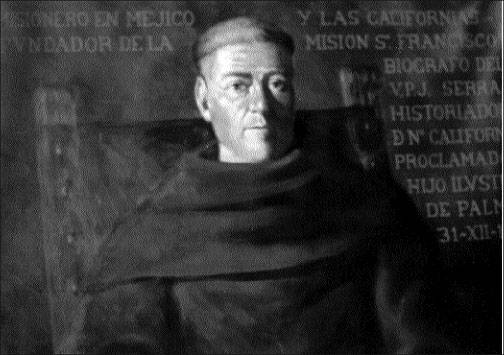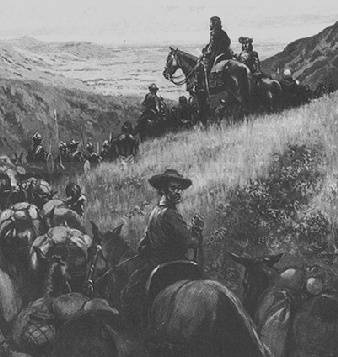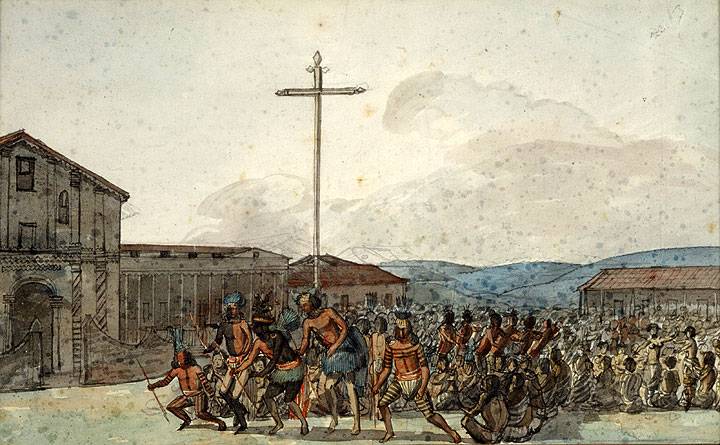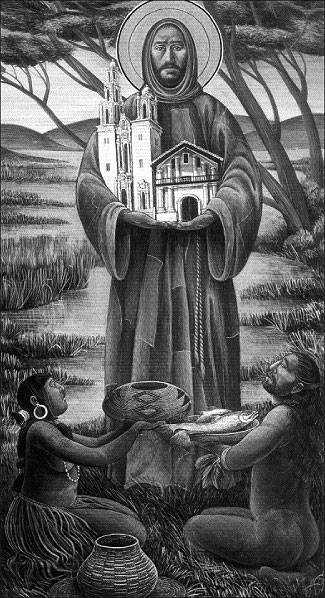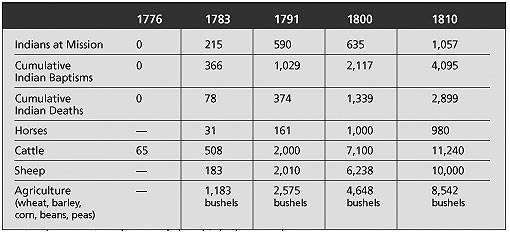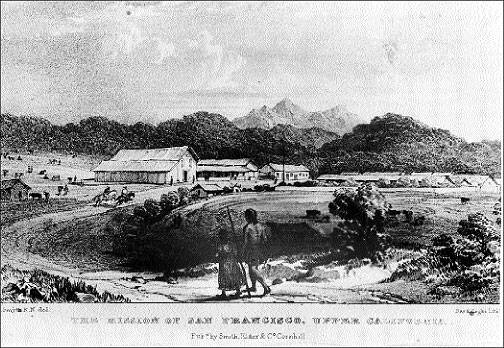Franciscan Dawn at Mission San Francisco
Historical Essay
By Brother Guire Cleary, S.S.F.
The First Years of Franciscan Exploration and Presence
at the Port and Mission of San Francisco de Asís: 1769-1810
A story is recounted by the first Franciscan pastor of Mission Dolores and reputedly California’s first historian, Fray Francisco Palóu, about the naming of San Francisco. When the Inspector General of Mexico in 1768 informed Fray Junípero Serra of the names of the missions to be established in Alta California, Serra remonstrated saying, “Sir, and is there to be no mission for Our Father St. Francis?” José de Gálvez jested, “If St. Francis desires a mission in his honor, let him see to it that his port is located, and his name shall be given to it.”1 The mythology of our city’s naming begins with a challenge and a jest. Like so much of our history, the story may have gotten better in the telling. Franciscan historian Maynard Geiger opines that Palóu may have “...deliberately dramatized an event in conversation which merely occurred in correspondence.”2 Drama is a remarkably consistent component of San Francisco’s history. That Gálvez is said to have had bouts of mental instability3 might also make him a model for the politics of our city. This article sets out some of the history of the Franciscans at San Francisco, from Serra’s desire for a mission to be named after the founder of the Order of Saint Francis to the apex of Franciscan prosperity in 1810. It cannot be repeated too often, however, that what commonly passes for the history of this region is merely the thinnest veneer of 230 years of Spanish, Mexican, and Anglo experience on a bedrock of 12,000-15,000 years of human community contained in the largely unrecorded history of the First Peoples.
Oil portrait of the founder of Mission Dolores and California's first historian, Fray Francisco Palou. The artist was Tomas Horrach Bibiloni of Palma, Mallorca, Spain. It is inscribed as follows, "Father Francisco Palóu, O.F.M. 1723-1789. Missionary to Mexico and the Californias, Founder of Mission San Francisco, Biographer of the Venerable Father J. Serra, Historian of Northern California, Proclaimed illustrious son of Palma, December 31, 1975. Gift of the city of Palma to Mission Dolores, October 9, 1976."
Photo courtesy of Joseph Flanders.
Serra’s inspiration was the Italian founder of the Order of Friars Minor, Francis of Assisi (1182-1226). It is worth noting that Francis had some experience as a missionary himself among the Muslims of North Africa. Ten years after the foundation of the Franciscan Order, a reluctant and exasperated sultan of Morocco personally executed five Franciscan missionaries on January 16, 1220. These missionaries had begun their mission in Seville, then a Moorish state. The response of the sultan was largely due to the arrogance and disrespect of the missionaries and their refusal to leave the country where they had abused the hospitality of their hosts by insulting Islam. In response to their deaths, Francis revised the rule of the growing Franciscan community, setting out a new model of missionization for his friars with these words: “As for the brothers who go [on missions], they can live spiritually among the Saracens and nonbelievers in two ways. One way is not to engage in arguments or disputes but to be subject to every human creature for God’s sake and to acknowledge that they are Christians.”4 Francis also urged his followers to be poor and to renounce positions of authority or management. He died of malnutrition and leprosy on October 3, 1226. Any comparison between this Francis and the Francis of the garden birdbath is sweet, but ultimately not the powerful reality. This model of zeal, self-effacement, and renunciation of wealth and power was the ideal of his followers who came to California under the Spanish Empire.5 The object of Serra’s labors was the winning of the hearts and souls of California’s aboriginal population.
Serra’s philosophical outlook was not only formed by Spanish culture and Christian morality. Serra had also been an academic in a Franciscan seminary in Majorca, Spain, as had Palóu. Fray Junípero was a philosopher of the school of Dun Scotus, who believed that God was discovered within communities. The goal of missionization was to create Christian societies where God’s love would be revealed in the relationships within human communities.6 Central to the efforts of the Franciscans at Mission Dolores was the idea of gathering native peoples into villages (reduccíon), inculcation of Christian doctrine and morality and European cultural values, establishment of Spanish law and government, and the creation of townships of Hispanicized farmers and artisans out of the indigenous population. Spanish law provided that Indian tribes entering the mission system would have their lands preserved intact under the management of the mission padres. The intention was to have self-governing pueblos in place within ten years.
Initial Explorations
Some confusion attends the European discovery and naming of San Francisco. The name “San Francisco” was originally given to a small bay near Point Reyes in 1595 by Spanish explorer Captain Sebastian Melendez Cermeño, who named it San Francisco Bay (Bahia de San Francisco). His ship, the San Augustin, was wrecked at this vicinity on November 30, 1595. In an amazing tale of seamanship, Cermeño and the remainder of his crew built a small vessel, possibly from local timber, and continued their explorations, sailing south to Mexico. The passage we call the Golden Gate and the great bays of San Pablo and San Francisco were not discovered by European nations until much later. Local Indians, possibly Miwok, supplied some food and this may have been the first Spanish contact with the Indians of San Francisco Bay.
Portolá sights the San Francisco Bay, November 4, 1769.
The first Franciscans to glimpse San Francisco Bay were Fray Juan Crespi and Fray Francisco Gomez. Setting out from San Diego in July 14, 1769, they were part of a search for Monterey Bay. Although earlier expeditions had described the physical appearance of Monterey Bay accurately enough, the party disbelieved their eyes due to an inaccurate establishment of Monterey’s latitude. Bancroft said it best: “Believing yet doubting they look over the bay and harbor of Monterey, then pass on wondering where is Monterey?”7 Trusting in their stamina, if not their map, they pressed on by foot another 125 miles north. October 4, 1769 was an important day for our local history. Crespi and Gomez both celebrated a Mass in honor of the Feast of San Francisco, and afterwards Gaspár de Portolá called for a council as to whether they should push on in hopes of finding Monterey Bay and the awaiting supply ship San Jose, or return to Mexico. They decided to push on, despite hardships, uncertainty, and many sick men. It was not until Sergeant José Francisco Ortega, under the command of Portolá, sighted the Golden Gate and San Francisco Bay on November 1, 1769 that Europeans became aware of the existence of the immense bay and its beautiful passage through the coastal mountains. Crespi and Gomez became the first Franciscans to view the immense port to be named after the founder of their community. Among Sergeant Ortega’s descendants is a twenty-first century woman who is also an Ohlone tribal elder.
In 1774, an expedition led by Captain Fernando Rivera y Moncada began explorations for a suitable site for the mission and presidio of San Francisco. Accompanying the expedition was Fray Francisco Palóu. Presents were made to Ssalson Ohlone of beads and Spanish food, including wheat and beans. Palóu records in his diary that the Indians were much taken with the products of European culture, and Palóu promised that he would return and help the First Peoples to plant seeds and gather them in abundance. Palóu believed that the Ohlone were pleased, understood him, and would help build houses when he came back. This was the pattern of missionization in California: Indians would be attracted by European technology and culture and, establishing their homes near missions, would ultimately accept Christianity and Spanish rule. On August 5, 1775, the Spanish naval vessel San Carlos became the first Spanish ship to enter San Francisco Bay, commanded by Captain Juan Bautista de Ayala and having Fray Vicente de Santa Maria as chaplain and missionary. The records of this exploration show a fascinating view of the natives of San Francisco Bay as courteous, awed by the wealth of Spanish culture, and warmly human. At one point Fray Santa Maria displayed an image of San Francisco de Asís that the Huchuin men kissed with such devotion that Santa Maria writes, “They stole my heart and the hearts of all who observed them.” An astonishing cultural intersection occurred on Angel Island on the afternoon of August 24, 1775. The eight Huchuin men, possibly tribal ambassadors, took out rattles and began singing what Santa Maria believed to be sacred songs with tears in their eyes. At the conclusion, they handed the Franciscan priest the rattles and indicated he should sing as well. In response Santa Maria sang the beloved Spanish hymn, Alabado. Nineteen years later, four of these men would be baptized at Mission Dolores. Sadly, this first dialogue of song and mutual respect was not the invariable tone of the cultural interaction between the worlds of Indians and Spanish-Mexicans.
Viceroy Antonio de Bucareli, concerned about the possibility of Russian encroachment on what he held to be unoccupied Spanish territory, ordered Captain Juan Bautista de Anza to recruit soldiers and settlers in Sonora, Mexico and establish a mission and presidio in the port of San Francisco. Franciscan Pedro Font went along to act as chaplain, historian, and scientist. Font’s diary reveals his love of nature, his enchantment with what met his eyes, and his hopes for the port of St. Francis. Looking out over the Bay from what is now the Presidio, he wrote that no place in his travels had ever pleased him more and that this port could be more beautiful than any in the world if settled like Europe. He described the discovery and naming of Dolores Creek and Dolores Lagoon: “Passing through wooded hills and over flats with good lands in which we encountered two lagoons and some springs of good water, with plentiful grass, fennel and other useful herbs, we arrived at the beautiful arroyo which because it was Friday of Sorrows, we called the Arroyo de los Dolores. On its banks we found much and very fragrant manzanita and other plants and many wild violets. I concluded that the place was very pretty and the best for the establishment of one of the two missions.”8 Mission San Francisco de Asís has as its common name “Mission Dolores,” which is taken from the name of the now vanished Dolores Lagoon and Dolores Creek.
1820 painting of European view of supplicating Indians seeking absolution from local priests... meanwhile, it was the local Native Americans who were actually building the missions and producing the surplus that the padres were trading with passing ships. Danse des habitantes de Californie a la mission de San Francisco ca.1815 by Louis Choris is one of the earliest depictions of Mission Dolores with both the missionaries and the Indians.
Image: Bancroft Library, Berkeley, CA (HN000275a)
The Establishment of the Mission and Presidio of Our Father San Francisco
On June 27, 1776, the colonists under the command of Lieutenant José Joaquin Moraga arrived along the shore of Dolores Lagoon, near what is now the intersection of Albion and Camp streets in the Mission District. The settlement party numbered about 193 people, including Padre Palóu and Padre Benito Cambón.9 The precise number and ownership of the 200 cattle accompanying their settlers is specified, but not the exact number of women and children. Under an arbor (enramada) built by Moraga’s soldiers, Palóu celebrated the first Mass on the feast day of Saints Peter and Paul, June 29, 1776. [Much innocent ink has been spilt over the issue of whether this date of June 29, 1776 constitutes the official birthday of the mission and the city of San Francisco. The author of this article is inclined to October 9, 1776.] Moraga’s soldiers and their families remained about a month and withdrew to found the Royal Presidio near the Golden Gate. One can only speculate as to the emotions of anxiety, curiosity, and excitement as Palóu and his small party watched the bulk of the settlers march three miles away, leaving them with Indians of unconfirmed intentions and with whom they had but a few words of common vocabulary. It was soon discovered that the Baja California Indian brought to Mission San Francisco as a translator did not understand the Ohlone language. I find this bit of naivété on the part of the missionaries to be somewhat surprising since at least some Ohlone words had been recorded on prior voyages to Alta California, and the earlier mission of San Carlos Borremeo in Monterey was within the Ohlone language region. The missionaries turned their attention to the establishment of the mission and the conversion of Ohlone Indians in the nearby village of Chutchui. Palóu inscribed the register of the mission on August 1, 1776 with the words, “The Mission of Our Father San Francisco, founded by Religious of the Holy Apostolic College of San Fernando at this Port of the same name of our Father San Francisco in Northern California, through the favor and at the expense of our Catholic Monarch, the King of Spain, Don Carlos III. Commenced at the same time that it was founded in the vicinity of the new presidio of the same name of San Francisco.” 10
The Mission was formally inaugurated on October 9, 1776. Its foundation is coupled with that of the Presidio. This relationship between religious and military was one of mutual dependence and also frequent antagonism as to differing goals and methods. Less than two weeks after Palóu wrote the above inscription, Ohlone Indians from what is now San Mateo attacked an Ohlone village near the newly established mission. The Indians near Dolores Lagoon were defeated and fled to Marin and Contra Costa, leaving the area even more depopulated. Anthropologist Randall Milliken speculates that the total Indian population of what is now San Francisco may have been as little as 160 persons at the time of the Spanish entrada.11 Hostilities between Spanish soldiers and Ohlone in December 1776 caused the remaining Ohlone population to avoid Mission San Francisco until March 1777. As Palóu wrote in his Historical Memoirs, “...the rest of the heathen came no more.”12 It would seem the new mission was a failure. Yet, somehow the first adult Indian baptism took place on June 24, 1777, when Chamis, a twenty-year-old Ohlone man, was baptized and given the Christian name of Francisco Moraga, with Lieutenant José Joaquin Moraga acting as godfather. Chamis later became the first Indian married at Mission Dolores, taking Paszém as his wife on April 24, 1778. The marriage register is still in the collection of Mission Dolores and is the seventh entry. The officiant was Francisco Palóu. Fray Palóu was deeply impressed with the tenderness of Indian families and found “...many married couples, both young and old, who live together in the most perfect union and peacefulness, loving their children dearly, as the children their parents.” 13
Material Progress
William Shaler of Connecticut visited most of the California missions from 1803-1805 and his was the first account of an American’s travels to California. He gave a rather accurate summation of the purpose of the California missions: “The plan of civilization in the missions is to instruct the Indians in the Catholic religion, the Spanish Language, the necessary arts, agriculture, etc.; the notion of private property is not admitted among them; so that each mission forms an indivisible society, of which the fathers are kings and pontiffs.”14
It must not be forgotten that it was the Indians of the California missions who created these immense agricultural, ranching, and manufacturing enterprises. The original Ohlone village of Chutchui may have had as few as sixty people in a few tule reed houses. Within one generation the Ohlone, Miwok, Patwin, Wappo, and Yokuts peoples of the Bay Area had built several churches and dozens of buildings, including housing, workshops, storerooms, granaries, mills, bathhouses, and aqueducts. The material progress of those first thirty-five years is astonishing.15
Father Palóu was a student of Father Junípero Serra, above, who appointed him as the principal missionary to found Mission San Francisco de Asís in 1776. Father Palóu is also known as the “father of California historiography.”
Photo courtesy of Joseph H. Flanders.
The Indian construction and agricultural projects at Mission San Francisco were equally remarkable for their accomplishment. The following list is based on the original research of Padre Maynard J. Geiger, OFM, who examined original reports and account books in California and Mexico.16
1776 – The first chapel, living quarters for the padres, corral, and aqueduct are built by Mexican servants and sailors.
1778 The mission now consists of a chapel, living quarters for padres and servants, kitchen, and women’s residence (monejero). The garden and threshing floor are enclosed, and several irrigation ditches, including a 3,025-foot-long aqueduct, are constructed.
1781-2 – Construction is completed of living quarters for servants and a second chapel is built of palisade, with new living quarters for the padres.
1783 – The location of the mission is moved some 1,100 feet west to its present site. A third chapel is built, and the foundations of the present chapel are laid. An unspecified first adobe building 68.75 feet long is completed.
1785 – The principal agricultural station of Mission San Francisco, called the Asistencia of San Pedro y San Pablo, is established at present-day San Mateo, some nineteen miles south of Mission San Francisco.
1786 – The Asistencia now consists of a storehouse (68.755x16.5 feet), chapel (28.9 feet long), and several rooms for storage.
1787 – A windstorm destroys the third chapel, which is either repaired or rebuilt. The Asistencia now has plastered palisade rooms for a missionary, a storeroom, and a kitchen. The area under cultivation is 6,630 feet in length. Willow trees and adobe walls ultimately enclose a plot extended to 8,250 feet. The garden includes peaches, quinces, and grapes.
1787 – Work begins on the walls of the existing Mission church. Some 26,000 adobe bricks are manufactured in three months and the walls are finished to the roof line. More rooms are added to the Asistencia, and wheat, barley, beans, peas, lentils, and maize are under cultivation.
1789-90 – The cloister at Mission San Francisco is completed, and the walls of the existing church are plastered and painted. The Asistencia adds a 1,375-foot irrigation ditch.
1791 – The present church is dedicated on August 2, 1791, making it the oldest intact mission church nave in California.
1792-3 – Two corrals with adobe walls, two buildings (each 35.75 feet long), and a guardhouse (162.25 feet long) are built. Nineteen adobe houses for neophytes and a building for grinding wheat are completed.
1794-5 – A warehouse (173.25 feet long) with a tile roof and a mile-long aqueduct are built. Roof tiles are laid on the present mission church.
1796 – Twenty adobe houses for neophytes, houses for soldiers, and a workshop (137.5 feet long) are completed. The Great Reredos and its statues arrive by ship from Mexico and are placed in their present positions. This altar has been described by the U.S. Department of the Interior as “...the most extraordinary piece of Spanish Baroque decorative art in North America, outside of Mexico.”17
1798 – The quadrangle at Mission San Francisco de Asís is completed.
1800-2 – Twenty-eight more adobe and tile homes for neophyte families and a similarly constructed bathhouse of adobe roofed with tile are completed.
Mission San Francisco in the days of its prosperity was drawn by Louis Choris ca. 1816. The Russian-born artist Choris (1795-1828) was a member of the Kotzebue expedition (1815-1816) and published his work in “Voyage Pittoresque Auteur du Monde.”
Photo: Society of California Pioneers
The only surviving building from the mission era is the present Mission Dolores church. While Palóu began the missionary work here in San Francisco, the pastorate of Benito Cambón (1782-1791) saw the real establishment of the mission’s enterprises and buildings. Cambón is credited as the architect of the current mission church. Frank J. Portman set out an excellent description of Cambón’s work in The Argonaut, in 1994.18 Portman was distinguished not only as an amateur historian but was the contractor who undertook the sensitive conservation of Mission Dolores in the early 1990s.
The labor, creativity, and skills of the Indians of the Bay Area created an astonishingly complex ranching, agricultural, and manufacturing enterprise at Mission Dolores and the other missions of California. While the process of conversion to Christianity was mostly voluntary, once baptized an Indian became the ward of the mission and subject to what today must appear to be an oppressive and controlling state. It is unclear if the neophytes understood the implications of a baptism after very brief catechesis. The new Christians (neophytes) would become the legal wards of the Franciscans and have most of their life informed, governed, and controlled by the padres and their alcalde. Setbacks at Mission Dolores included a mass exodus of 280 people in the summer of 1795 due to the three muchos: too much work, too much punishment, and too much hunger. Periodic epidemics of measles, smallpox, and diphtheria drastically reduced mission populations. Syphilis and bacterial infections took immense tolls. Franciscans quarreled with each other and wrote letters of complaint to their superiors about the Indians, the soldiers, and sometimes each other. This history has a remarkably human and modern feel to it.
Assessing the Padres
How do we of the twenty-first century assess the Franciscan padres? There has been a spectrum of opinion from the beginning. Alexander Forbes summed up the ambivalent position and virtues of the California Franciscans in 1839:
He [the Franciscan missionary] is the absolute lord and master of all his Indians...commands all the human beings under his charge; and all without being accountable to any power on earth; for by a convenient fiction, this property belongs to the Indians, and the Indians are his slaves. And yet I have never heard that the missionaries of California have not acted with the most perfect fidelity, or that they ever betrayed their trust, or exercised inhumanity. There are recorded instances of the most extraordinary zeal, industry and philanthropy in the conduct of those men.19
Helen Hunt Jackson commemorated their virtues in Ramona, her 1884 novel about the end of the mission era.20
The first statue placed by the State of California in the United States Capitol was that of Padre Serra. The partnership between the Franciscans and the military was an uneasy one then, and the ramifications of that working relationship trouble many consciences even today. At the 100th anniversary celebration of the founding of Mission San Francisco de Asís, General Mariano G. Vallejo summed up the relationship between the missionaries and the military: “The mildness of the minister of God upheld by the force of armed men produced the desired effects.”21 In this same remarkable centennial address, Vallejo’s positive comments on the Franciscans included “intrepid” and “gifted with wondrous fortitude,” but he also accused the order of liquidating the mission cattle at the time of the secularization in order to send money out of the country. Modern opinion shares similarly divergent views. In San Francisco there has been some controversy recently over relocating statues of Hispanic pioneers Juan Bautista de Anza and his sovereign King Carlos III due to a view by some that they represent genocide and imperialism. People as separated in time as La Perouse (1791)22 and contemporary Indian historian Ward Churchill23 have compared the mission labor system to slave plantations and the public works projects of Nazi Albert Speer. Dr. Doyce Nunis, Jr., wrote in one debate over the padres, “To impose on the past our contemporary views is to defame and distort the historical record.”24 The Franciscans of that era are dead and quite beyond our reproof, interrogation, or correction. While we cannot impose our views on the past, it is our task to learn from the mistakes of the past and build a just San Francisco, or in time be judged harshly ourselves.
Epilogue
On the morning of September 16, 1810, a bell was rung in Dolores. Not our Mission Dolores – in fact, Mission San Francisco de Asís was not to be called Mission Dolores for another fifteen years. In the town of Dolores in the state of Guanajunto, Father Miguel Hildago y Castilla rang a bell to signal the beginning of the Mexican War of Independence, delivering his cry of independence with the words, “Death to the Spaniards! Long live the Virgin of Guadalupe!” Significantly, he also exhorted the people “Take! My children! Because everything is yours!” 25 Echoes of that bell were to be heard as far away as Alta California, and it would become a tolling bell as the Franciscan missions entered their greatest years of prosperity and at the same time experienced the beginning of forces which would result in their secularization. Hildago’s words were addressed to his Indian parishioners. In Alta California, however, it was the Californios who would be doing the taking from the Indians. Soon, the begrudging support of the military and retired military population of California by the missions would became a source of resentment for the Californios, who were forced to come begging to the Franciscans with sombreros in hand. Adelbert von Chamisso visited San Francisco in 1816 with the Russian ship Rurik and reported that while the missions had an abundance of food, soldiers of the presidios had not eaten bread in years and what few supplies they had received from the Franciscans were only provided after the signing of promissory notes. Artillery Officer Miguel de la Luz Gómez told Chamisso, “Our leaders are too good! They should requisition, demand that they [the Franciscans] provide what we need!”26 Eventually the tables would be turned and it would be the Franciscans who would be at the mercy of the military and civil government.
This article originally appeared in The Argonaut vol. 14, no. 1, 2003.
ABOUT THE AUTHOR
Brother Guire Cleary, S.S.F., is a Franciscan friar of the Episcopalian Church. He is Curator of the Mission San Francisco de Asís.
NOTES
1. Palóu, Francisco, Life of Fray Junípero Serra, trans. and ed. Maynard J. Gieger, OFM, (Washington: Academy of American Franciscan History, 1955), p. 80.
2. Ibid, p. 385.
3. Paddison, Joshua, A World Transformed (Berkeley: Heyday Books, 1999), p. 4.
4. Armstrong, OFM, Regis J., ed., Francis of Assisi: Early Documents, vol. 1 (New York: New City Press, 1999), p. 74.
5. For discussion of the ethical conflicts Franciscan missionaries faced as successful entrepreneurs, merchants, ranchers, farmers, and manufacturers, see Cleary, Guire, S.S.F., “Poverty and Wealth: Franciscan Dilemma in the Alta California of 1769-1835” (California Mission Studies Association); available here.
6. Schwab, OFM, Joseph, “The California Missions: Past as Prologue,” The Cord 49, no. 2 (March/April 1999), pp. 85-88.
7. Bancroft, Hubert, History of California, vol. 1 (Santa Barbara: Wallace Herberd), p.150.
8. Font, Pedro, Font’s Complete Diary, trans. and ed. Herbert Eugene Bolton, (Berkeley: University of California Press, 1931), pp. 341, 346-47.
9. Langellier, John Phillip and Rosen, Daniel B., El Presidio de San Francisco (Spokane: Arthur H. Clark Co., 1996), p. 30, Appendix B.
10. Libro de Bautismos (Baptismal Register ca. 1776), Collection of Mission Dolores, San Francisco, California.
11. Milliken, Randall, A Time of Little Choice (Menlo Park: Balena Press, 1995), p. 53.
12. Palóu, Francisco, Historical Memoir of New California, vol. 4, trans. and ed. by Herbert Eugene Bolton (Berkeley: University of California, 1926), pp.135-38.
13. Palóu, Fray, “The Founding of the Presidio and Mission of Our Father St. Francis,” trans. George E. Dane, California Historical Society Quarterly, XIX (June 1935), p. 110.
14. Shaler, William, Journal of a Voyage from China to the Northwestern Coast of America. Contained in Francis Webber’s “Prominent Visitors to the California Missions” (Los Angeles: Dawson, 1999), p. 45.
15. Englehardt, Zephyrin, OFM, San Francisco or Mission Dolores (Chicago: Franciscan Herald Press, 1924), pp. 270, 283-84.
16. Geiger, Maynard J., OFM, “Early Churches at San Francisco,” California Historical Society Quarterly, XLVI (September 1967), pp. 195-205.
17. Ward, Clarence R., Mission San Francisco de Asís (Washington: Historic American Buildings Survey, 1938), pp. 4-8.
18. Portman, Frank J., “Pedro Benito Cambón, OFM: Mission Builder Par Excellence,” The Argonaut, vol. 5, no. 2 (Fall 1994).
19. Forbes, Alexander, California: A History of Upper and Lower California (New York: Arno Press, reprint 1973), pp. 226-27.
20. Jackson, Helen Hunt, Ramona (Boston: Little, Brown & Co., reprint 1939).
21. Davis, William Heath, 75 Years in California: A History of Events and Life in California (San Francisco: John Howell, 1929), p. 361.
22. Margolian, Malcom, Life in a California Mission: The Journals of Jean Francois La Peruse (Berkeley: Heyday Books, 1989), p. 81.
23. Churchill, Ward, A Little Matter of Genocide (San Francisco: City Lights Books, 1997), pp. 142-43.
24. Nunis, Doyce B., Jr., Ph.D., in “Painting an Unfair Picture of the Friars,” La Gazeta del Archivo (Spring/Summer 1999), p. 23.
25. Krauze, Enrique, Mexico: Biography of Power (New York: Harper Collins Books, 1997), p. 92.
26. Chamisso, Adelbert von, “A Voyage Around the World,” in A World Transformed, ed. Joshua Paddison (Berkeley: Heyday Books, 1999), pp. 141-42.

